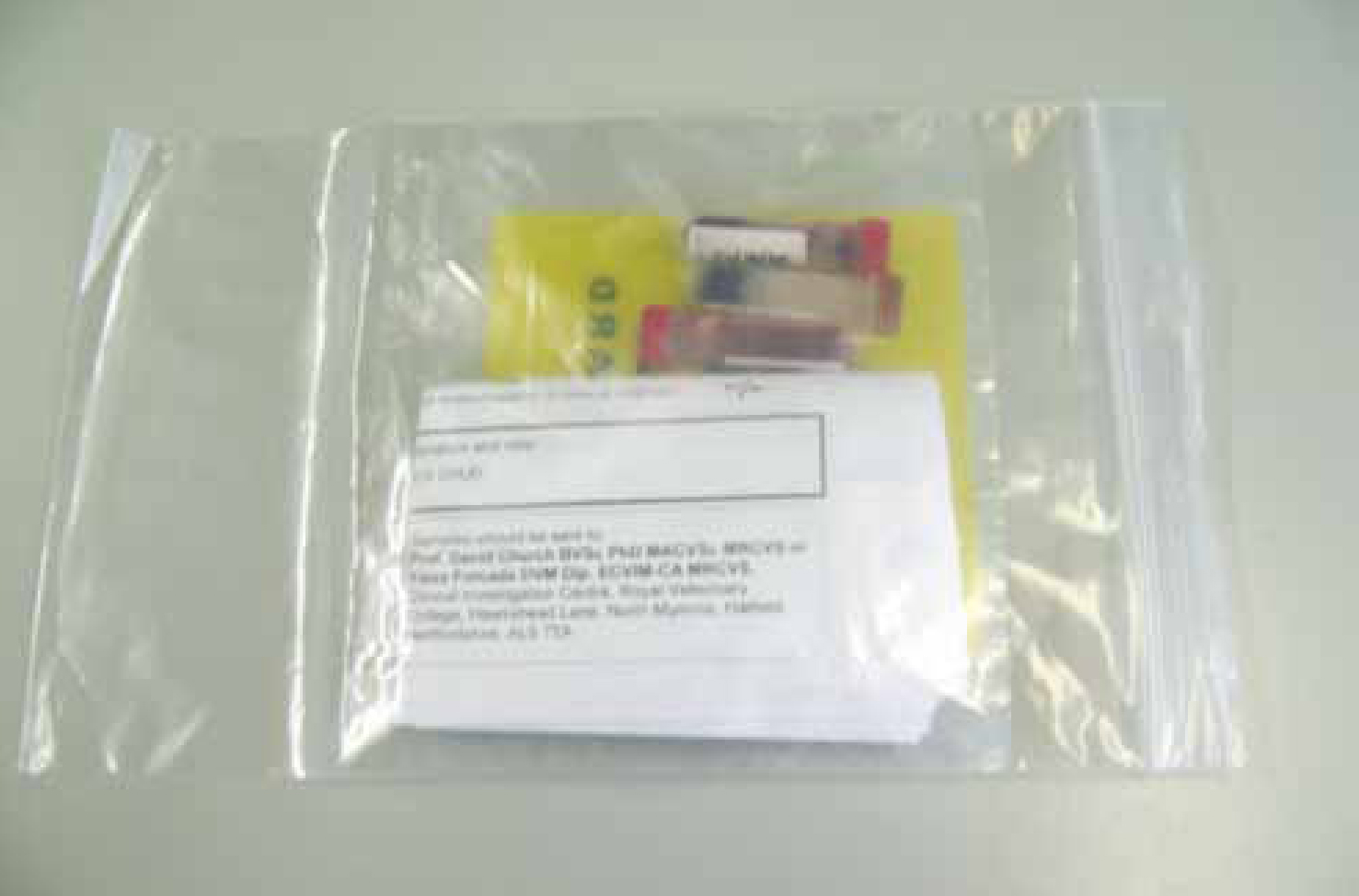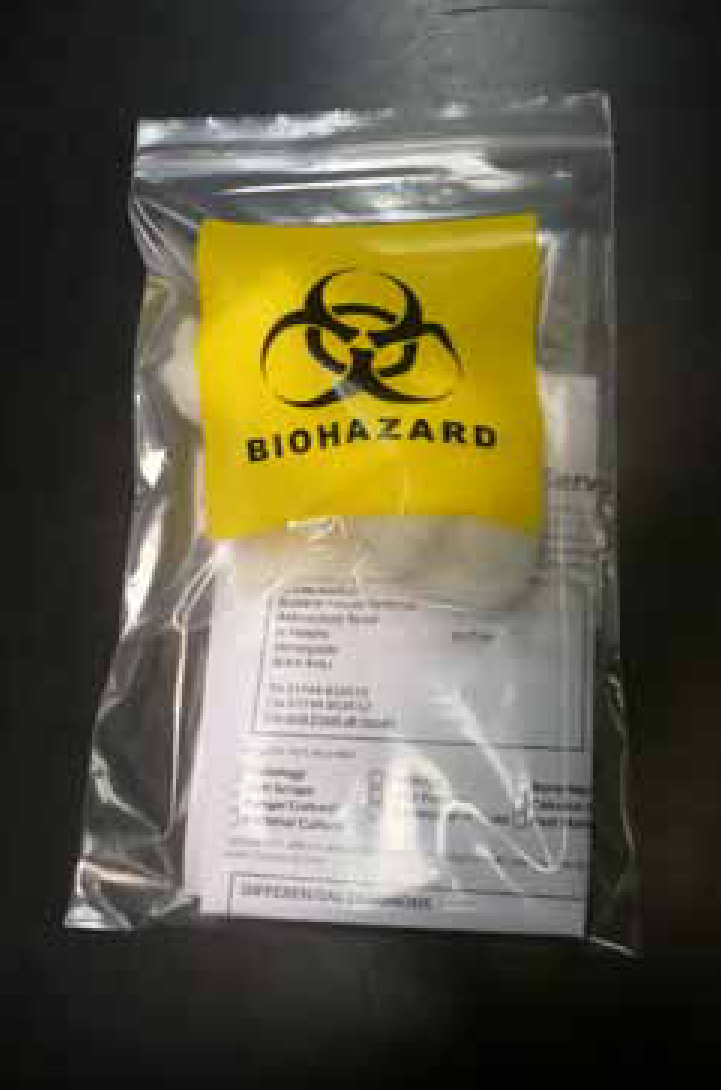While veterinary surgeons are trained to interpret laboratory results, it is the veterinary nurse (VN) who is trained to assist in producing the results required for diagnosis (Pratt, 1997). Packaging and sending samples is often the role of the VN and is a role of importance as incorrect handling of the samples could affect analysis and the ultimate results. Samples typically sent include blood, urine, faeces and tissue although this will largely depend on the facilities of the veterinary practice. In additional to ensuring samples reach their destination in diagnostic quality, those involved in sending samples have a responsibility to the people involved in this process. Personnel involved with collection and delivery of these samples have a justified concern about exposure to potentially infectious organisms (World Health Organisation (WHO), 2007) so it is essential to ensure the packaging used meets requirements. Working in a laboratory that receives samples daily from veterinary practices has allowed the author to observe the frequency of errors that can affect the analysis of the samples. This paper has been designed to provide an overview of how to package and send samples correctly and to identify the problems that can arise should guidelines not be followed.
When might a VN be required to package and send a sample?
In practice, diagnostic purposes are often the reason for a VN being asked to package and send a sample for analysis. Samples may be sent to an external laboratory for analysis because the practice does not have the equipment required or because the analysis is technically difficult and requires highly trained staff. VNs have a responsibility to ensure that the sample is correctly labelled and stored and to organise the most appropriate form of transport (Pinches, 2008). This is to ensure sample integrity and to minimise the effect that transport affects the validity of the results.
Research studies are sometimes undertaken that accept samples through the post, and while such studies may also offer diagnostics, the samples are primarily used for research purposes. An example of this is the Royal Veterinary College's Acromegaly trial which accepts blood samples from diabetic cats to investigate Acromegaly (Clinical Investigation Centre, 2013).
VNs working in a clinical research setting can be required to send samples to different research centres, especially if the research is being conducted as a collaborative study. This is commonly when samples are sent via courier using dry ice and ice packs depending on which temperature the samples need to be kept at.
Laboratory requirements
It is imperative that the samples are stored appropriately, accurately labelled, the paperwork fully completed and the samples packaged in accordance with the relevant guidelines. This will differ depending on the type of sample being submitted; for example, it is inappropriate to package fungal hair cultures in plastic biohazard bags as this can affect the results. Veterinary practices may supply their own specific guidelines regarding sending samples or the laboratory being used may need to be contacted. By following such guidelines, pre-analytical errors which affect the sample can be reduced (Pinches, 2008). Table 1 identifies some common causes for pre-analytical errors and how the VN is instrumental in reducing these from occurring.
| Pre-analytical error | How the veterinary nurse can minimise error |
|---|---|
| Incomplete or inaccurate sample labelling | Confrming patient details are correct |
| Incorrect sampling technique | Ensuring that only trained staff collect the sample |
| Sample contamination | Not allowing contamination with other surfaces, samples or media; for example, EDTA contamination. |
| Clotting of blood | Thoroughly mixing sample immediately after collection |
| Delayed sample analysis | Ensuring samples can be submitted and analysed before collecting sample |
| Improper sample storage | Following guidelines to ensure sample integrity. If unsure, contact laboratory directly to confrm |
| Incorrect patient preparation | Ensuring the patient has been prepared for the sample to be taken such as starvation prior to a bile acid stimulation test |
Table 1 highlights the importance of the VN in ensuring the sample reaches the laboratory in a suitable condition.
Sample collection
Before sampling the patient and sending the tubes, it is advisable to check that the samples meet the requirements for what is needed for the diagnostic tests and/or research samples. Submitting incorrect samples is classified as a pre-analytical error and this phase is considered to be the most important part of the diagnostic testing process (Kalra, 2004). The author has occasionally seen samples submitted that are not all required for a research study and diagnostic tests despite there being instructions for the tubes to be submitted. The instructions in this particular example were provided on a sample collection sheet. Despite this, incorrect samples were still submitted. This error can be corrected before sampling the animal for example, by checking with the laboratory which samples are required. Error causes a waste of blood and tissue, and from an ethical perspective, results in more sample being collected from an animal than necessary. This is important in both a research setting and when samples are taken for diagnostics. One aim when designing a study is to reduce the number of animals required to give meaningful results, which can be done in a variety of ways including modifying the experimental procedures (Baumans and Van Loo, 2013). By collecting the correct samples, the need for unnecessary resampling is eradicated. In extreme cases, laboratories may reject samples where the wrong sample has been submitted (Archer, 2005), for example, if blood intended for phenobarbitone monitoring is submitted in an EDTA tube.
Packaging
Packaging requirements are in place to ultimately protect the people involved in handling the samples during shipping to their destination and it is essential for packages to be accurately labelled to indicate the content. Consideration should be paid to how the packaging will protect the sample integrity during shipping. For example, microscope slides should be held in a slide holder to protect the slides from becoming damaged and it is common for bubble wrap to be used to provide extra protection. Figure 1 below shows a sample incorrectly packaged for transportation.

Two steps should have been taken for the sample to be classed as packaged correctly. First, the submission form should be moved from the sealed sample compartment and put in the designated paperwork compartment. This is done to prevent paperwork contamination should the sample leak and also to allow the receiver to read the details of the animal before having to handle the sample. Second, enough absorbent material, for example cotton wool, should be applied around the sample so that in the event of leakage or damage of parcels in transit, the sample does not leak out of the package (Figure 2).

The packaging required will depend on the type of samples being shipped and whether the samples need to be kept at a particular temperature. Wet and dry ice can be used to preserve the samples where required.
Wet ice can be used as a transportation media when samples need to be kept between 2–8°C, similar to a refrigerator but it is essential for the packaging to be leak proof (WHO, 2007). Samples dispatched on wet ice will need to reach the laboratory speedily as the ice will melt, ideally within an hour, unless the courier is able and prepared to replace the ice. Samples in this instance should be kept in polystyrene boxes.
Dry ice is used when samples have been stored in a freezer, with different freezers ranging from −20°C to −80°C. Due to the risks involved with improper use of dry ice, such as explosions (WHO, 2007) all users will need to have completed a course allowing them to use the refrigerant safely. As a result of this, it is unusual to use dry ice in a general practice setting and it is more often used in larger institutes, such as research centres.
The importance of accurate information
Volmer and Meerdink (2002) state that laboratory results provide the most meaningful information when a thorough case history is supplied. Regardless of whether samples are submitted as part of a clinical trial or for diagnostic purposes, they should be accompanied with a form providing details of the case as well as sampling information, such as when the sample was collected.
Clerical errors such as incorrect labelling and transcription errors are avoidable and often occur due to simple mistakes (Pratt, 1997). Such errors can result in delays in reporting results and potentially incorrect diagnosis and treatment of the patient. See Step-by-step guide.
Interpretation of results
Laboratories design submission forms to obtain the information required for successful interpretation of results. It is essential for the submission form to be fully completed, which is something often VNs are responsible for. Failure to fully complete the submission forms can lead to incorrect interpretation or cause the laboratory to call the practice for more information. Included in the testing cost will be a fee for interpretation of the results so all information should be provided to allow for a thorough service.
Future research studies
Much time is invested into devising submission forms where samples are sent in as part of clinical trials to ensure that participants provide all information required for the study. Depending on the consent obtained, this information may also be used for future studies where it would be classed as retrospective data (Blane, 1996). Such data would be of use in studies of a clinical audit design, which could be completed at a research centre or by an external laboratory.
Conclusion
As it is often the VN's responsibility to package and send samples, VNs need to be aware of the reasons for ensuring that guidelines are adhered to. By completing all information as required and sending the necessary samples, VNs play a key role in diagnosis and research.
